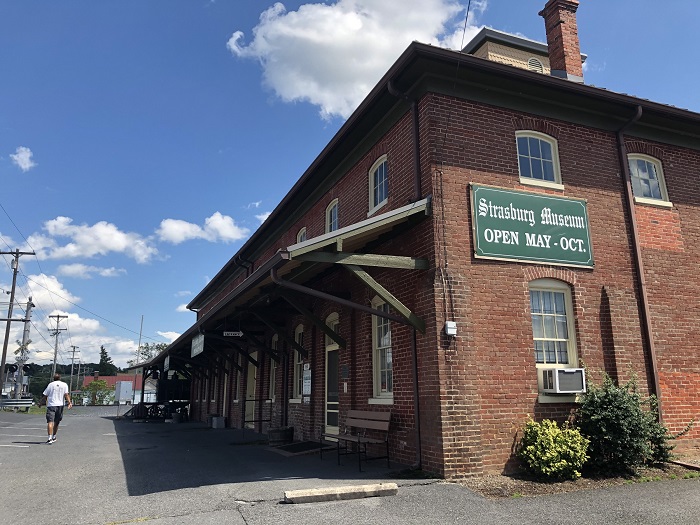Interesting Things to Know
Strasburg once Central Valley center for pottery
European Settlers began residing in the enchanting Northern Shenandoah Valley during the 1730s. Peter Stover migrated to the Shenandoah Valley in 1739 and eventually purchased 483 acres of land from Jacob Funk. Stover divided the land into smaller plots for sale to other settlers and a village was informally established. Stover then applied for a town charter from Virginia’s Colonial General Assembly in November 1761 giving the fledgling community the official name of Strasburg after Strasbourg, the capital of the German-speaking French province of Alsace. Some settlers originally called the area Staufferstadt, the German name for Stoverstown.
Unlike English society found east of the Blue Ridge, Strasburg was settled with family farms and villages rather than large estates and was greatly influenced by Germanic values, customs and languages. The prosperous agricultural community that developed in the bountiful low lying land along a large bend of the North Fork of the Shenandoah River featured scenic views of the Massanutten Ridge to the east and Allegheny Mountains to the west.
Strasburg would gradually boast a strong mercantile base that supported blacksmiths, doctors, carpenters, potters, coopers, weavers, hatters, shoemakers, tavern keepers, stonemasons, millers, tanners and potters. However it was for the pottery industry that Strasburg would increasingly be recognized. A Sabbatarian commune trekked to Strasburg from the Ephrata Cloister in Pennsylvania with a desire to reproduce rural folk art pottery. This Christian group of celibate men and women migrated to the Valley about 1757 and in 1761 established the first cottage industry pottery production.

Attached Photo courtesy Mark Gunderman. The Strasburg Museum, once operated as a Steam Pottery, also known then as the Strasburg Stone and Earthenware Manufacturing Company from 1891-1909.
In the early nineteenth century potters from other colonial locations were arriving and establishing small shops. Shops accepting apprenticeships were primarily limited to family members. The agrarian society had great needs for pottery products. Potteries were built for making utilitarian devices used in cooking meals and food storage. Rich Valley earthen and stoneware clay deposits were readily accessible and abundant which enticed potters to Strasburg to take advantage of owning a shop with a cheap clay source in close proximity. Earthenware was used for cooking and stoneware was suitable for storing liquids. Salt-glazed stoneware became very available during this time and potters made serviceable household products like cream pitchers, lard crocks, whiskey jugs and chamber pots.
Philip Grim was most likely Strasburg’s first commercial potter. Phillip began producing pottery in 1783 and continued here until 1811. Adam Keister began making pottery in Strasburg in 1805 and produced his first stoneware during the 1820s. His sons Adam Jr. and Henry continued the business from 1847 until after the Civil War. Samuel Bell moved to Strasburg from Winchester to make pottery in 1843 and his brother Solomon Bell joined him in 1845. Pottery continued to be a commercially viable industry prior to the Civil War, with local clay being used to make both utilitarian items and decorative pieces.
The ravages of the Civil War brought lean years to the Shenandoah Valley, thus diminishing the pottery industry. Many potteries severely cut production during the war years and financing to increase production after the war was difficult. Skilled Potters were abundant but salaries were below normal standards for the years 1865-1875. Competition was intense during this period and the phrase “poor as a potter” was widely used.
The most successful period for the Strasburg pottery trade came a decade after the war during what has been called the “Golden Age” of Valley pottery production (1875-1895). This Golden Age was the result of voluminous stoneware production when many partnerships were formed and dissolved. The Potters were able to transport their stoneware throughout the southeast and mid-Atlantic states via the Manassas Gap Railroad which connected Strasburg to Manassas Junction and Alexandria and the new Winchester and Strasburg Railroad which connected Strasburg to Harpers Ferry, enabling a connection to northern destinations.
It was during the Golden Age that a number of small potteries were distinguished here and Strasburg became a potter’s paradise earning its signature nickname of Pot Town. Pot Town became the Central Valley headquarters for the production of both utilitarian and fancy earthenware and stoneware pottery. Commonly produced stoneware forms of the late nineteenth century include jars, crocks, jugs, pitchers, butter and cake crocks, milk pans (shallow, tapering crocks with spouts) and spittoons.
Samuel H. Sonner produced ware from 1870 to 1883. His son John Henry Sonner assumed the business and continued making stoneware and drain tile into the early 1900s. George W. Miller produced pottery from 1880-1901. James M. Hickerson managed his pottery in Strasburg, Virginia from 1884-1898. Jacob J. Eberly & Company opened in 1874. Eberly acquired Keister Pottery in 1880. Eberly’s brother Joseph and son Letcher joined him later, producing stoneware and fancy ware until the early 1900s. Letcher is recognized for creating the poly-chrome glaze used in earthenware products in Strasburg. Samuel and Solomon Bell’s business continued to grow producing various saleable items with Samuel Bell’s potter sons, Richard Franklin “Polk” Bell, Charles Forrest Bell, and Turner Ashby Bell. Ashby became the last surviving potter working, by producing lavishly decorated commercial products in Strasburg as late as 1915.
Around 1890 the two story structure that now houses the Strasburg Museum was built by the Strasburg Stone and Earthenware Manufacturing Company as a factory intended to place the Shenandoah Valley’s long tradition of pottery making on a high-volume industrial basis. The factory idea was conceived by Dr. G. A. Brown and a group of investors from Lynchburg and Strasburg.
The plan was to make Strasburg an important manufacturing center elevating the city’s status to the level of more modern Trenton, New Jersey and Zanesville, Ohio. The company began operating the large steam pottery plant on the site beginning in February 1891. The project coincided with the brief economic boom experienced during the city’s Golden Age.
Many of the Strasburg area independent potters became employees of the company and local laborers sought permanent employment at 50 cents a day. Unfortunately the organization did not have the necessary experience for operating in a large factory environment. There were many delays getting the operations component running smoothly as management had difficulty with the various technological phases and challenges of the new industrial era.
By 1894, large amounts of inventory remained unsold. In 1895 and 1896, the factory mostly produced brick and tile. The company officers recognized glass jars and tin cans were rapidly replacing pottery for food storage. Efforts to diversify the product line with additional items like flower pots and brightly-glazed tableware were not enough to sustain the steam pottery plant. The short-lived venture (1891-1897) into specialized industrial and technological advancement represents an unsuccessful attempt to convert a small production industry into one of innovative mass production. Between 1898 and 1900 the company wholesaled all of their machinery and pottery related equipment.
Strasburg pottery production went into decline because of competition from large, well-managed Ohio-based factories, the transition of food storage from ceramic vessels to the use of lighter-weight glass jars and new canning devices. The gradual mass production of glass jars and tin cans as more efficient types of containers ultimately led to the rapid end of salt-glazed stoneware and the pottery industry. By 1910, virtually all remaining commercially productive potters in the Valley area sought out new means of employment.
Strasburg stoneware is admired today for its folk art charm and Southern legacy. It is believed that no other community of similar size is as well-known as Strasburg among nationwide pottery collectors.
Mark P. Gunderman
Stephens City, Virginia
Interesting Things to Know
Groundbreaking Gene Therapy Brings Hope to Deaf Children
In an extraordinary leap forward for medical science, a team of researchers from Harvard Medical School and the Massachusetts Eye and Ear Infirmary has pioneered a gene therapy trial that promises a world of change for children born deaf. This clinical trial in China focused on children aged 1 to 7, all born completely deaf due to an inherited gene mutation.
Gene therapy, a revolutionary technique, works by inserting normal genes into cells to replace missing or defective ones. The deafness of the children in this trial was traced to a specific condition known as DFNB9, which was attributed to a mutation in the OTOF gene. This gene is crucial as it encodes otoferlin, a protein essential for transmitting sound to the inner ear. Without functional otoferlin, sound signals cannot reach the brain, resulting in total deafness. However, it’s important to note that this condition doesn’t cause any physical damage to the inner ear, making these children ideal candidates for gene therapy.
Five of the six children who underwent this pioneering treatment experienced significant improvements within 26 weeks. These children, who had lived in silence since birth, were suddenly able to understand and respond to speech and even recognize speech amidst noisy environments. Unfortunately, one child did not show any improvement, and researchers are still trying to understand why.
This trial not only opens new avenues for treating deafness but also kindles hope for advancements in gene therapy for various other conditions. The success observed in five out of six participants marks a significant milestone in medical science, showcasing the potential of gene therapy as a life-changing treatment for individuals with genetic disorders. As this research continues to evolve, it may pave the way for addressing other forms of deafness and potentially a myriad of genetic conditions affecting people around the globe.
Interesting Things to Know
Cultivating Patience: The Key to Enhanced Productivity and Fulfillment
Patience isn’t just a virtue; it’s a skill that can transform your work, relationships, and personal growth journey. In our fast-paced world, the urge to rush through tasks and milestones is common, but slowing down can unlock deeper understanding and greater efficiency. Here’s a simple exercise to help you develop patience in all aspects of life:
Value the Process: Instead of focusing solely on the end goal, embrace the journey. No matter how mundane, each task offers its own lessons and experiences. Recognize the value in what you’re doing right now.
Visualize Slowing Down: Notice when you’re hurrying and mentally picture yourself moving at a more measured pace. Imagine engaging with your work or conversation more deeply, absorbing the nuances and wisdom it offers.
Pause and Breathe: Whenever you catch your mind racing ahead, take a moment to breathe deeply. This physical pause can help reset your mental pace, anchoring you in the present and allowing you to engage fully with the task or moment at hand.
In her book Inner Gardening: Four Seasons of Cultivating the Soil and the Spirit, Diane Dreher advocates for this mindful approach, highlighting how slowing down enhances our focus and leads to significant insights. By practicing patience, we can enrich our understanding, improve our performance, and find joy in the paths we’re walking, both professionally and personally.
Interesting Things to Know
Celebrating the Joy and Power of Reading on World Book and Copyright Day
April 23 marks a special occasion for book lovers around the globe: World Book and Copyright Day. Established by UNESCO, this day is dedicated to appreciating books’ unique role in our lives, promoting the joys of reading, and recognizing the rights of authors and publishers. Books are more than just a hobby; they are a treasure trove of knowledge, entertainment, and inspiration connecting us across time and cultures.
The Multifaceted Benefits of Reading
Engaging with books offers a myriad of benefits, both for the mind and soul:
- Entertainment: With an endless variety of genres, there’s a book for every taste and interest, offering unparalleled escapism and enjoyment.
- Education: Reading expands your knowledge, introducing you to new ideas, cultures, and perspectives.
- Vocabulary and Language Skills: Regular reading enhances your vocabulary and improves your understanding of language nuances.
- Creativity and Imagination: Books stimulate the imagination, encouraging creative thinking and problem-solving skills.
- Concentration and Focus: Immersing yourself in a book requires concentration, which can improve your attention span over time.
- Stress Reduction: Reading has been shown to lower stress levels, providing a peaceful retreat from the hustle and bustle of everyday life.
- Memory Improvement: The act of reading and following complex narratives can strengthen memory and cognitive functions.
- Empathy: Literature often puts you in the shoes of its characters, fostering empathy and understanding of diverse human experiences.
- Neurological Health: Engaging with books can also contribute to long-term brain health, potentially reducing the risk of Alzheimer’s and other neurodegenerative diseases.
Celebrate With a Visit to Your Local Bookstore or Library
This World Book and Copyright Day, take the opportunity to explore the magic of books. Visit a local bookstore or library to discover new titles, revisit old favorites, or even participate in events celebrating the power of reading. It’s a perfect time to enrich your personal library and share the love of reading with friends and family.
Understanding Copyright Law
Copyright law plays a crucial role in protecting the rights of authors, illustrators, and publishers, ensuring they can continue to create and share their work. Respecting copyright by obtaining permission before using someone else’s creative output is essential. This supports the creators and fosters a healthy culture of respect and appreciation within the literary community.
As we celebrate World Book and Copyright Day, let’s acknowledge the invaluable contributions of those who bring books into our lives and commit to supporting their rights. Whether through buying books, borrowing from libraries, or advocating for authors’ rights, we can all play a part in sustaining the vibrant world of literature.
Interesting Things to Know
Celebrate National Arbor Day: Plant a Tree and Beautify Your World
April 26 marks National Arbor Day, dedicated to planting trees and fostering a deeper appreciation for their crucial role in our environment. The tradition began in 1872 when J. Sterling Morton of Nebraska highlighted the importance of trees to a thriving ecosystem. This day has since evolved into a nationwide observance, encouraging individuals and communities to plant trees and engage in activities that promote environmental stewardship.
Trees are more than just a scenic addition to our landscapes; they are essential to energy conservation in ways comparable to insulation or weather-tight windows and doors. By providing shade in the summer and acting as windbreaks in the winter, trees significantly reduce the energy needed to heat and cool our homes. It’s estimated that three strategically placed shade trees can lower air conditioning costs by up to 30 percent. This is not just a contribution to individual savings but also a substantial benefit to the environment by reducing the demand for energy.
The choice of tree species plays a significant role in maximizing these benefits. Deciduous trees, which shed their leaves in winter, are perfect for blocking heat in the summer while allowing sunlight to warm homes during the colder months. Placing these trees on buildings’ south and west sides optimizes their shade during the hottest parts of the day and seasons. Additionally, shading hard surfaces like driveways can further minimize the heat load on surrounding areas.
On the other hand, Evergreens retain their foliage throughout the year, making them excellent windbreaks that can significantly reduce a home’s heating energy consumption. When planted on the north side of a home, evergreens can shield against cold winter winds while still providing shade in the summer months.
National Arbor Day is an opportunity to impact our planet and communities positively. By planting a tree, you contribute to energy conservation, beautify your surroundings, and support a healthier environment. Whether you’re planting a deciduous tree to cool your home in the summer or an evergreen to protect it from winter winds, each tree planted is a step towards a greener, more sustainable world.
Interesting Things to Know
Rethinking Returns: The Shift in Retail Return Policies
Interesting Things to Know
The Power of Creativity and Innovation in Shaping Our World
Creativity and innovation are the lifeblood of human progress. In a world that’s rapidly evolving, the ability to innovate—to conceive new ideas, products, and solutions—is more valuable than ever. April 21 marks World Creativity and Innovation Day, a global celebration recognized by the United Nations to highlight the importance of these skills in driving human development and solving some of the world’s most critical issues.
Why Creativity and Innovation Matter
Creativity is not just the realm of artists and musicians. It encompasses problem-solving, the design of new technologies, and the development of strategies to address global challenges. It’s about looking at problems from fresh angles and finding solutions that break the mold. Investing in creativity and innovation isn’t merely an investment in individual talents; it’s an investment in our collective future.
Economic Growth and Opportunity
One of the most tangible benefits of fostering creativity and innovation is economic development. By encouraging the creation of new businesses and industries, we open up a plethora of job opportunities. Innovation drives competitiveness, improves products and services, and significantly enhances productivity. For countries and regions, this can translate into increased economic stability and growth, making the investment in creativity and innovation a powerful tool for economic empowerment.
Tackling Global Challenges
Perhaps even more critically, creativity and innovation are key to addressing the world’s most pressing problems, such as climate change, poverty, and famine. Through innovative thinking, we can develop sustainable technologies, create new social and economic development models, and find efficient ways to distribute resources. The challenges we face are complex and interconnected, requiring out-of-the-box thinking and novel approaches that only a strong commitment to creativity and innovation can provide.
Supporting Local Creatives
World Creativity and Innovation Day also serves as a reminder of the importance of supporting local talent. Behind every local business, whether it’s a boutique storefront or a factory in an industrial park, there’s a team of creative individuals working to invent new products, improve services, and solve problems. By choosing to shop locally, we contribute to our local economy and encourage innovators and problem-solvers who are building a better future from the ground up.
Investing in creativity and innovation is investing in the future. It’s about fostering an environment where new ideas can flourish, challenges are met with ingenious solutions, and economic growth is driven by forward thinking. As we celebrate World Creativity and Innovation Day, let’s commit to supporting the thinkers, creators, and innovators in our communities and beyond. Their vision and hard work enhance our daily lives and pave the way for a more sustainable, equitable, and prosperous world for all.


















